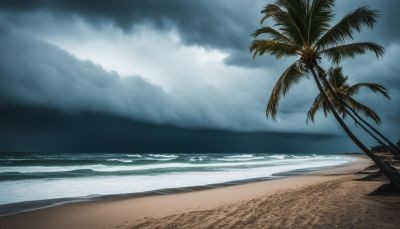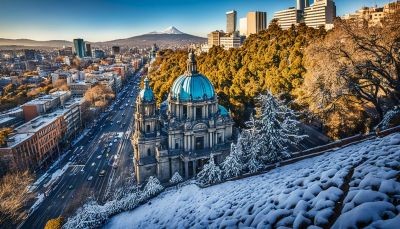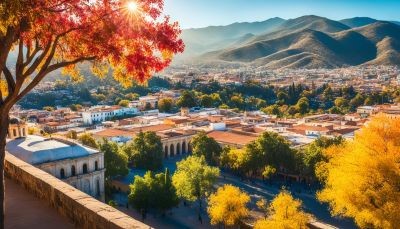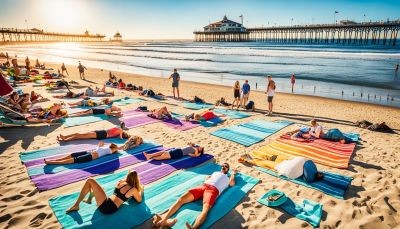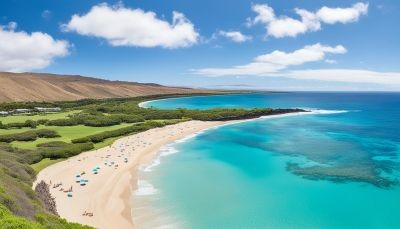Dreaming of a sunny beach escape? Playa del Carmen is a top pick. This beach city on the Yucatan Peninsula shines with its beaches and lively vibe. It started as a calm fishing village and grew into a modern hotspot. It's loved for its warm weather and friendly feel.
But, the best time to go matters. We'll check out the weather to find the perfect months for your trip.
Key Takeaways
- The best months to visit Playa del Carmen are April, May, and October through March, offering ideal beach weather and fewer crowds.
- The dry season from October to March provides sunny days and slightly cooler evenings, making it a prime time to enjoy Playa del Carmen's beautiful coastline.
- The rainy season from June to November coincides with the Atlantic hurricane season, so it's crucial to monitor weather forecasts and advisories during this time.
- Playa del Carmen's tropical climate is influenced by the nearby Caribbean Sea and Gulf of Mexico, contributing to its diverse weather patterns.
- Shoulder season months like April and May offer the opportunity to experience Playa del Carmen with fewer crowds and lower prices.
Introduction to Playa del Carmen, Quintana Roo
Playa del Carmen is a stunning coastal town. It merges European vibes with laid-back beach life. Once a small fishing village, it has grown into a lively place for those who love luxury. People from far and wide, including Europe, visit here.Vibrant Coastal Town on the Yucatan Peninsula
This town sits beautifully on the Yucatan Peninsula's coast. It meets the Caribbean Sea with its clear blue waters. Playa del Carmen was once quiet but has bloomed into a bustling spot offering great food, fun shopping, and entertainment.Blend of European Sophistication and Beachside Relaxation
Playa del Carmen stands out with its mix of elegance and beach spirit. Its streets are packed with fancy stores, cool bars, and top-notch eateries. Yet, it keeps a chill vibe for all to enjoy. The beautiful Quintana Roo nature also calls for visitors to relax and soak in its tropical beauty.Playa del Carmen's Weather Patterns
Playa del Carmen is on the stunning Yucatan Peninsula. It has a tropical climate because of the nearby Caribbean Sea and Gulf of Mexico. This makes it have distinct dry and rainy seasons throughout the year.Tropical Climate with Distinct Dry and Rainy Seasons
The dry season in Playa del Carmen is from October to March. It's a perfect time for visitors. They can expect sunny days, pleasant temperatures, and very little rain. It's a wonderful time to enjoy the tropical climate and the area's Caribbean Sea and beaches.However, the rainy season is from June to November. This period overlaps with the Atlantic hurricane season. There can be heavy rain, more humidity, and even storms from the Gulf of Mexico. It's important to keep an eye on the weather forecast if you plan to visit then.
Influence of the Caribbean Sea and Gulf of Mexico
The Caribbean Sea and Gulf of Mexico greatly affect Playa del Carmen's weather. They bring warm, moist air that leads to the dry and rainy seasons. This mix makes the weather interesting and varied during the year.It's key to be aware of Playa del Carmen's weather when planning your trip. Doing so will help ensure a great vacation on the Riviera Maya.
Best Months for a Beach Vacation in Playa del Carmen
The best months for a beach vacation in Playa del Carmen are April, May, and October through March. The shoulder season of April and May offers fewer crowds and great weather. Temperatures range from 70-90°F. It's a perfect time to relax on the coast without the big summer crowds.From October to March is the dry season, perfect for beach days. You'll have sunny days and cool evenings. This is the best time to visit Playa del Carmen and enjoy the beach. During this time, there are fewer people and you can find good deals. It's a great chance to see the town at its best.
Avoiding the Rainy Season and Hurricane Risks
As you plan a trip to Playa del Carmen, knowing about the rainy and hurricane seasons is key. The region's rainy time usually falls between June and November. This aligns with the Atlantic hurricane season.June to November: Rainy Season and Hurricane Potential
The rainy period brings frequent heavy rains to Playa del Carmen. It also increases the chance of hurricanes hitting the area. These conditions can spoil your plans and might even be risky. It's crucial to keep an eye on weather forecasts and weather advisories. They'll give you the latest on any storms or severe weather.Monitoring Weather Forecasts and Advisories
Keeping track of weather forecasts and weather advisories will be very helpful. It can guide you on when it's safer to visit Playa del Carmen. Doing this can shield you from runs-ins with the bad weather of the rainy season and hurricane season. Remember, it's all about being flexible and ready to change your plans if needed for a safer and happier trip.Playa del Carmen, Quintana Roo: Best Months for a Weather-Savvy Trip
The best time to visit the charming coastal town of Playa del Carmen, Quintana Roo, is from April to May. Also, from October to March is great. These months have the best weather, perfect for a trip to this tropical haven.In April and May, the place is less crowded and prices are lower. Temperatures are lovely, ranging from 70 to 90°F. From October to March, it's the dry season. This season is ideal for beach activities because of sunny days and cooler nights. It's a great time to enjoy the shore and the town of Playa del Carmen.
Yet, be careful about the weather forecasts and advisories for your travel. The rainy season from June to November is also the Atlantic hurricane season. This brings risks of heavy rain and strong storms. Keeping track of the weather will help make your Playa del Carmen visit a success even during these times.
Top Attractions and Activities in Playa del Carmen
Playa del Carmen has top attractions and many diverse activities. There's La Quinta Avenida at its heart. This area has lots of high-end boutiques, fun bars, and great dining options. It's perfect for shopping, dining, and enjoying the nightlife.La Quinta Avenida: Shopping, Dining, and Nightlife
Walking down La Quinta Avenida is special. You'll see beautiful architecture and a vibrant atmosphere. There are many shops selling everything from fashion to local crafts. Enjoy eating, from Mexican food to dishes from around the globe. At night, bars and music make it lively.Nearby UNESCO World Heritage Sites and Natural Wonders
Playa del Carmen is close to amazing places. Visit Chichen Itza to see ancient Mayan ruins. Or explore Río Secreto's underground rivers and Xel-Há's natural aquarium. You'll be amazed by what you find.Water Sports and Beach Activities
The area's beaches and clear waters are perfect for activities. Try snorkeling, diving, paddle boarding, or kayaking. If you prefer to relax, the beach is a great spot. You can sunbathe and enjoy the sea breeze.Accommodations and Travel Tips
Planning a trip to Playa del Carmen offers an array of stays. You can choose from luxurious resorts to cozy boutique hotels, depending on your budget and taste.Choosing the Right Resort or Hotel
For the best stay, look for a hotel or resort that fits your style and budget. Playa del Carmen has options for those wanting luxury or a more local feel. Think about location, what they offer, and what others say to pick your dream spot.Getting Around Playa del Carmen
It's easy to get around Playa del Carmen. You can walk to explore La Quinta Avenida, the lively main street. For farther places, local buses and taxis are cheap and handy.Local Customs and Etiquette
Know the local ways in Playa del Carmen. The local currency is the Mexican peso. Also, the dress code is casual, fitting its beachy vibe. This helps you fully enjoy the local lifestyle.Budgeting for Your Playa del Carmen Vacation
Planning a trip to Playa del Carmen means thinking about your budget. Flight and hotel costs change a lot depending on when you go and where you stay. Look out for deals, especially during peak seasons, as this is when these prices tend to be higher.Cost of Flights and Accommodations
How much you spend on your flight to Playa del Carmen depends on where you're flying from and when you go. Similarly, where you choose to stay can be from a low-cost hotel to a fancy resort. It can help to be flexible with your dates and compare prices to save money on both.Dining and Entertainment Expenses
The food and entertainment choices in Playa del Carmen can impact how much you spend. There are places to eat for every budget, like the beachside or fine dining. Don't forget to include the cost of nighttime fun, such as bars and clubs, in your budget.Excursions and Activities
In Playa del Carmen, you can take part in many exciting activities. These include visiting World Heritage sites and enjoying water sports. Look into the activities you want to do before you get there to include them in your budget.FAQ
What is the climate like in Playa del Carmen, Quintana Roo?
Playa del Carmen feels the heat of a tropical climate. It has both dry and rainy seasons. The dry season, from October to March, is perfect for the beach. Be prepared for heavy rain and the chance of hurricanes from June to November.
What are the best months to visit Playa del Carmen for a beach vacation?
April, May, and October through March are ideal for beach lovers in Playa del Carmen. These months escape the busy crowds and offer great weather. You'll enjoy temperatures between 70-90°F. The cooler and less humid time, from October to March, is also perfect for beach activities.
What should I be aware of during the rainy season in Playa del Carmen?
Playa del Carmen's rainy season lasts from June to November, the same time as the hurricane season. This means a lot of rain and the risk of hurricanes. Keep up with the weather forecast if you plan to visit then. This lets you avoid any bad weather and stay safe.
What are some of the top attractions and activities in Playa del Carmen?
If you're visiting Playa del Carmen, there's plenty to do and see. The city's heart is La Quinta Avenida. It teems with bars, shops, and more. You can also explore nearby heritage sites like Chichen Itza or natural spots such as Río Secreto. Don't forget about the water and beach fun. The town's beaches are known for their beauty and clear waters.
What should I consider when booking accommodations and getting around in Playa del Carmen?
Playa del Carmen has everything from luxury resorts to smaller hotels. Do some research to find what fits your style and budget. As for getting around, you can walk, take the bus, or grab a taxi. It's good to remember local customs, too. The Mexican peso is the currency, and the dress code is usually relaxed.
How much should I budget for a trip to Playa del Carmen?
Making a budget for Playa del Carmen involves a few things. Flights and where you stay can cost different amounts. Remember to include costs for food, fun, and any trips you want to take. This can be for exploring ruins, water sports, or the nightlife.
